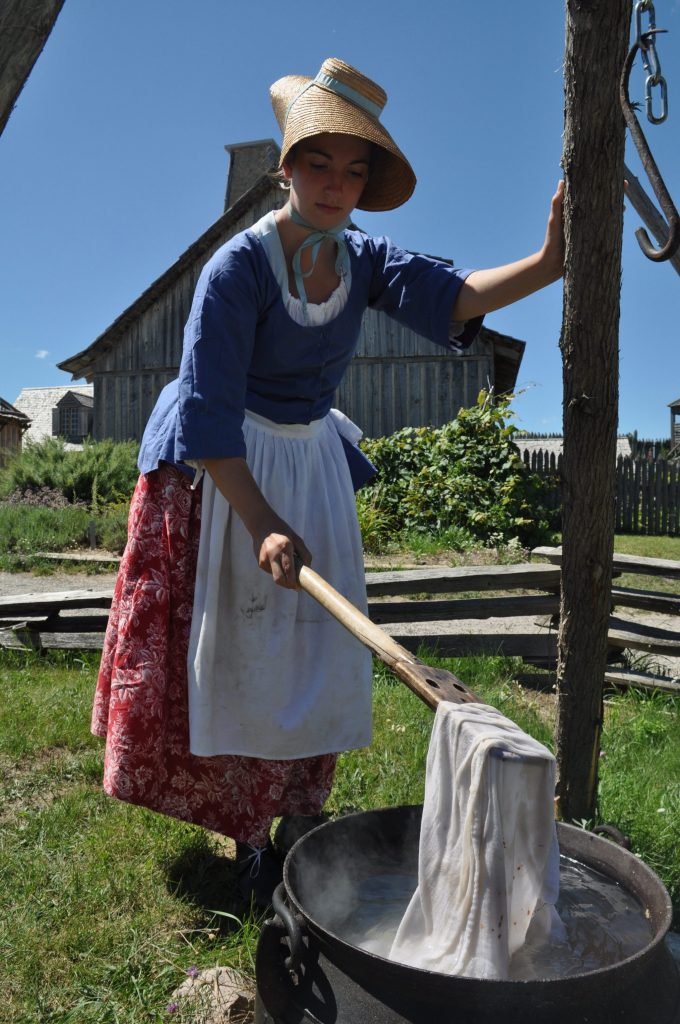If you have visited Colonial Michilimackinac recently, you may have noticed a few changes, including new exhibits, new gardens, and whole new buildings. A new addition in 2017 will be a weekly laundry demonstration at the Soldier’s House. Although our interpreters won’t be washing your socks, it is still worth a visit to see how the enlisted men’s wives were working in the 1770s.
An enlisted man in the British military could generally not marry a woman unless he had permission from his commanding officer. At Michilimackinac, we know that a few of the men did manage to gain permission and were able to bring their wives with them to their new post. In most regiments, six women per company were allowed to follow the men on campaign and on garrison. These ladies were subject to the same regulations and discipline as the men, and were required to work. Many of these women became laundresses.
 As you might guess, laundry in the 18th century was not as simple as it can be today. The most basic garments at the time were made out of linen. Linen was very much desired for its affordability and durability. It could be boiled, soaked, scrubbed and boiled again while showing few ill effects in the tough fibers. Linen was used for shirts, breeches, shifts, petticoats, gowns, and many other types of garments. After linen, wool was the next most common fabric. Wool is durable and versatile, but usually cannot be boiled like linen. Wool military uniforms were brushed to keep them clean. The men’s white wool breeches and waistcoats could be washed a little more thoroughly, as long as they did not undergo quick temperature changes or too much agitation. Once clean, clothing was laid in the sun to dry. When that was not possible, lines were strung outside or inside near the fire to allow clothing to dry.
As you might guess, laundry in the 18th century was not as simple as it can be today. The most basic garments at the time were made out of linen. Linen was very much desired for its affordability and durability. It could be boiled, soaked, scrubbed and boiled again while showing few ill effects in the tough fibers. Linen was used for shirts, breeches, shifts, petticoats, gowns, and many other types of garments. After linen, wool was the next most common fabric. Wool is durable and versatile, but usually cannot be boiled like linen. Wool military uniforms were brushed to keep them clean. The men’s white wool breeches and waistcoats could be washed a little more thoroughly, as long as they did not undergo quick temperature changes or too much agitation. Once clean, clothing was laid in the sun to dry. When that was not possible, lines were strung outside or inside near the fire to allow clothing to dry.
When it came to cleaning solutions, our historic laundress had many options at her disposal. Laundry soap was in widespread use in the 1770s and shows up on inventory lists at Michilimackinac. Laundresses generally reserved it for rubbing stains, rather than soaping the whole tub of clothing. Another option for cleaning clothing involved soaking linens in lye, which is an excellent degreaser. Ammonia could be used to remove ink spots and the sun was used to whiten whites.
Textiles were expensive in the 1770s and labor tended to be cheap. When clothing went out to the laundress, she often also mended seams and patched holes. In order to keep clothing from going home with the wrong person, it was almost always marked. For civilians and upper class officers, their garments may have been marked with the initials of the owner and perhaps an inventory number. The mass produced clothing provided for the enlisted men was sometimes marked with permanent paint. Shirts were numbered at the front center to be easily checked when the men were inspected.
How often do you wash your laundry? Does it vary? In the 1770s it varied a lot. Wealthier people tended to have more clothing, so they could wear a fresh shirt every day and only need to send their clothing out to be laundered once every couple of weeks. Lower class people did not have that many changes of clothing, so tended to need to do laundry more often. Additionally, many items of clothing that did not directly rest on the skin rarely needed to be washed.
No matter when it is done, laundry is usually not a desirable task. However, there was more to the job of a professional laundress at Michilimackinac than it may seem. Stop by and talk to our laundress about her work and to learn more about women at Colonial Michilimackinac.









